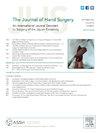二、三、四角关节融合术治疗腕中骨关节炎:一项系统综述和荟萃分析。
IF 2.1
2区 医学
Q2 ORTHOPEDICS
引用次数: 0
摘要
目的:作为舟月骨晚期塌陷和舟骨骨不连晚期塌陷的一部分,一些有限的腕中关节已被用于腕中骨关节炎的治疗。两腕关节融合术(2CA)、三腕关节融合术(3CA)、双柱关节融合术还是四腕关节融合术(FCA)的效果最好,目前尚无共识。本研究的目的是确定腕中骨关节炎患者接受FCA、3CA、2CA或双柱关节融合术的结果是否存在差异。方法:根据系统评价和荟萃分析指南的首选报告项目,在多个数据库中进行系统评价和荟萃分析。包括报道这四种手术技术的研究。主要结果是术后视觉模拟量表疼痛评分,手臂、肩部和手部残疾评分,以及Mayo手腕评分。次要结果是活动范围、握力和报告的并发症。结果:在2270项符合条件的研究中,选择了80篇文章,包括2166个腕关节。根据患者可接受症状量表,2CA组和FCA组的视觉模拟疼痛评分均达到足够的疼痛减轻。手臂、肩膀和手的残疾得分在这两组之间也具有可比性。在屈伸和尺桡偏弧方面,2CA组的活动范围也明显优于FCA组。FCA组骨不愈合发生率为6.9%,而2CA组为10.0%。结论:尽管2CA手术在理论上比FCA有优势,但数据分析表明,一般来说,这些技术具有相似的结果和并发症。因此,对于舟月骨晚期塌陷腕关节和舟骨骨不连晚期塌陷腕关节,2CA和FCA都是很好的选择。研究类型/证据水平:治疗性IV。本文章由计算机程序翻译,如有差异,请以英文原文为准。
Two-, Three-, or Four-Corner Arthrodesis for Midcarpal Osteoarthritis: A Systematic Review and Meta-Analysis
Purpose
Several limited midcarpal arthrodeses have been used in the treatment of midcarpal osteoarthritis as part of scapholunate advanced collapse and scaphoid nonunion advanced collapse. There is no consensus on whether two-carpal arthrodesis (2CA), three-carpal arthrodesis (3CA), bicolumnar arthrodesis, or four-carpal arthrodesis (FCA) results in the best outcomes. The objective of this study was to determine whether there is a difference in outcomes in patients undergoing FCA, 3CA, 2CA, or bicolumnar arthrodesis for midcarpal osteoarthritis.
Methods
A systematic review and meta-analysis were performed in multiple databases following Preferred Reporting Items for Systematic Reviews and Meta-Analyses guidelines. Studies reporting the four surgical techniques were included. The primary outcomes were postoperative visual analog scale pain score, the Disabilities of the Arm, Shoulder, and Hand score, and the Mayo Wrist Score. The secondary outcomes were active range of motion, grip strength, and reported complications.
Results
Of 2,270 eligible studies, 80 articles were selected, including a total of 2,166 wrists. The visual analog scale pain scores for both the 2CA and FCA groups reached an adequate pain reduction based on the Patient Acceptable Symptom Scale. The Disabilities of the Arm, Shoulder, and Hand score was also comparable between these two groups. The 2CA group also showed a significantly better active range of motion than the FCA group for both flexion-extension and radioulnar deviation arc. The incidence of nonunion was 6.9% in the FCA group compared with 10.0% in the 2CA group.
Conclusions
Although the 2CA procedure has a theoretical advantage over the FCA method, the analysis of data showed that generally, these techniques have similar outcomes and complications. Therefore, both (2CA and FCA) are good options for midcarpal osteoarthritis in scapholunate advanced collapse and scaphoid nonunion advanced collapse wrists.
Type of study/level of evidence
Therapeutic IV.
求助全文
通过发布文献求助,成功后即可免费获取论文全文。
去求助
来源期刊
CiteScore
3.20
自引率
10.50%
发文量
402
审稿时长
12 weeks
期刊介绍:
The Journal of Hand Surgery publishes original, peer-reviewed articles related to the pathophysiology, diagnosis, and treatment of diseases and conditions of the upper extremity; these include both clinical and basic science studies, along with case reports. Special features include Review Articles (including Current Concepts and The Hand Surgery Landscape), Reviews of Books and Media, and Letters to the Editor.

 求助内容:
求助内容: 应助结果提醒方式:
应助结果提醒方式:


